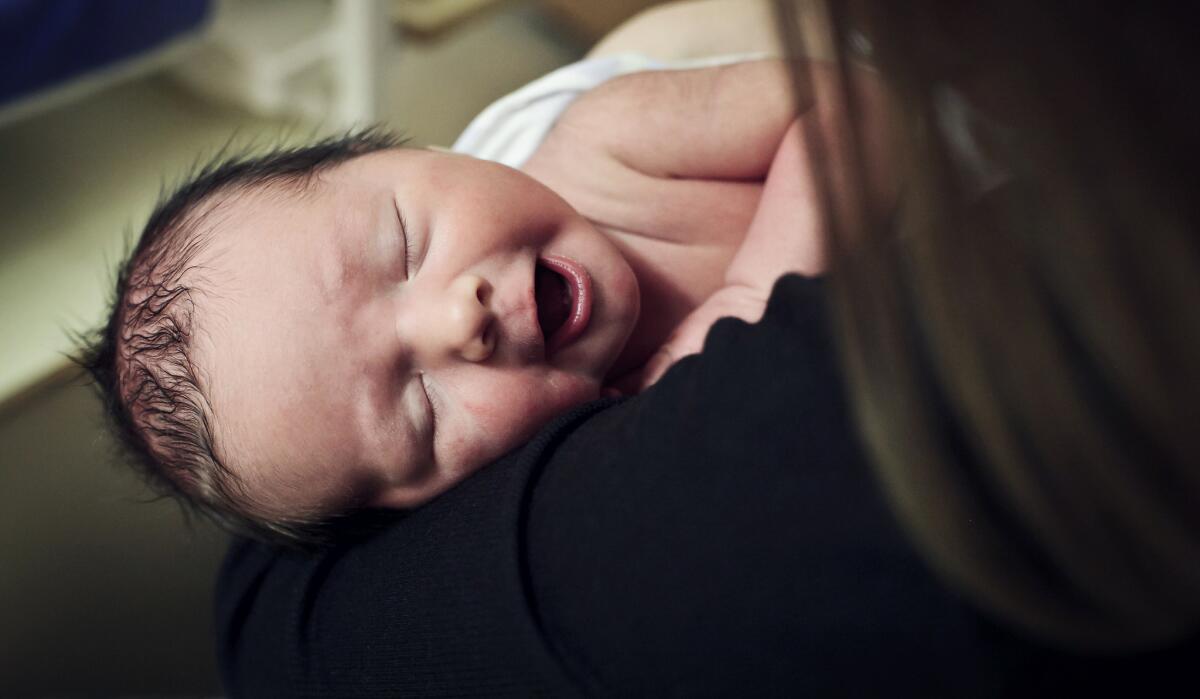A big push for a different birthing experience

- Share via
For most of the last 25 years or so, the experience of pregnancy, labor and delivery has changed little for most women. But change is coming to the most traditional setting, the hospital.
And it’s being spurred by midwives, labor coaches called doulas, forward-thinking physicians and women who don’t want “medical” births but don’t necessarily want to have their babies at home either.
“We are mammals, and we birth like mammals,” says Ana Paula Markel, a certified doula and founder of Bini Birth, a childbirth education and doula-training center in Sherman Oaks. “Women need very simple things during labor: We need to feel safe and warm, we need quiet and darkness, we need to feel like we aren’t being observed and we need to be able to move around.”
In a hospital, she says, women haven’t typically been free to try those simple things. Until now.
Her last point, about being free to move, is one that Cedars-Sinai Medical Center in Los Angeles is embracing with its new “Rock-and-Roll” program. Often, when a woman is in labor and has been admitted to a hospital, she is also in bed. But staying in bed slows labor and, some experts believe, increases the need for medication and the risk of a caesarean section delivery. At Cedars-Sinai, women are encouraged to change position every 20 minutes or so, even if they’ve had an epidural for pain relief.
“The program has reduced the number of C-sections at Cedars by 8% and reduced the length of time that women labor by 20%,” says Nicole White, a hospital spokeswoman.
Cedars-Sinai, along with St. John’s Health Center in Santa Monica, offers delivery privileges to midwives. “One of our jobs is promote a sense of normalcy about labor and birth, and less fear,” says Deborah Frank, a certified nurse midwife and the first CNM to be granted privileges at Cedars-Sinai. Frank says that most midwives aren’t “anti-technology or even anti-medication,” but neither do they believe that every birth calls for medical intervention.
Frank encourages laboring women to walk and to have her partner, a midwife or a doula at her side. Having a midwife in attendance is still relatively rare: According to a 2012 report in the Journal of Midwifery & Women’s Health, 11.4% of vaginal births were attended by midwives in 2009 (the most recent statistics available).
As for women who give birth by caesarean, they can expect changes too.
Even though the percentage of caesarean births in the U.S. has stabilized — it increased steadily from 1996 to 2010 from just more than 20% to 32.8% — nearly one-third of babies are born by C-section each year.
In the March issue of OBG Management, Dr. William Camann, director of obstetric anesthesiology at Brigham and Women’s Hospital in Boston and an associate professor of anesthesia at Harvard Medical School, co-wrote an editorial, “Mother-, Baby-, and Family-Centered Cesarean Delivery: It Is Possible,” in which he explained some of the options that have become available in the last couple of years.
For example, instead of using an opaque drape to create a surgical shield, two drapes are put in place: a solid one and a clear one. Once the doctor has made the necessary incisions and is ready to deliver the baby, one drape is lowered, leaving the clear plastic drape in place. This allows the mother and her partner to view the birth and touch the baby through the clear drape, while preserving a sterile surgical area.
A second change is one that Camann describes as “slowing the delivery process.” Normally a baby is removed from the mother’s uterus within seconds. But by allowing the baby to remain in the uterus after the head emerges, the uterus can contract around the baby, and at the same time, the baby starts to breathe and cry. Some experts believe this helps babies clear their respiratory system of fluid (babies born by C-section have a higher risk of respiratory problems), Camann says.
There are even doulas who specialize in assisting women during a surgical delivery.
“The mothers who have doulas in the OR are more involved and not as detached from the birth experience if their physician is more open to the concepts of a family-centered birth,” says Tara Poulin, a certified doula in Boston. Even small changes, such as putting the IV in the non-dominant hand, putting the heart-monitor leads on the woman’s back and letting her initiate breast feeding make the experience less stressful, she says.
The bottom line: “There seems to be more willingness among [obstetricians and] anesthesiologists to involve the dad/partner into the process, and even to welcome doulas and midwives into the delivery room, whether it is a caesarean or vaginal delivery,” Camann says.
Free webinar on family-centered C-sections
Dr. William Camann, director of obstetric anesthesiology at Brigham and Women’s Hospital in Boston and the author of the book “Easy Labor: Every Woman’s Guide to Choosing Less Pain and More Joy During Childbirth,” recorded a free webinar that explains the family-centered caesarean section.






